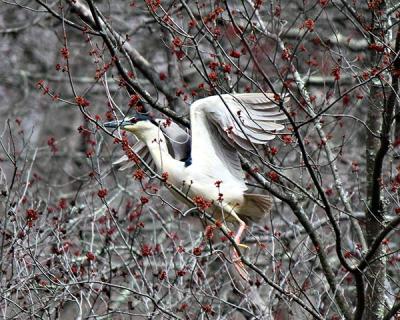Nature Notes: If It’s Not One Thing . . .

The current building boom has laid down a lot of big trees before they had a chance to leaf out, but it apparently hasn’t deterred the birds from returning from the south. While some osprey nesting platforms continue to go barren, like the one on the edge of Northwest Creek in Barcelona and another in the marsh off of Gerard Drive in Springs, many traditional pairs are back including those at Multi Aquaculture and other annually occupied venues on Napeague, and around Accabonac Harbor, Sag Harbor Cove, and North Sea Harbor. They’re feeding on whatever they can — alewives are few and far between thus far and winter flounders have practically disappeared.
I wonder if the one on the platform in the field on the west side of Deerfield Road far from any water body will bring forth chicks once more or the platform will be abandoned. A very bright spot in osprey reproduction locally is the return of a pair of ospreys to the nest in upper Sag Harbor Cove to the west of Otter Pond in Sag Harbor. That nest has remained barren for at least four years following the death of the female after a run of almost 15 consecutive years. Anton Hagen, who lives nearby, is worried that the crows in the area, which are wont to harass the pair, will spoil their return.
Other fish-eating water birds have returned to familiar haunts. Great blue herons, black-crowned night herons, great and snowy egrets, as well as the glossy ibis are all back in town. Terry Sullivan has been regularly checking out and photographing the birds that hang around and wade in Sagg Pond’s upper stretches and on Saturday there was one or more of every kind. On Sunday the Third House Nature Center group, with its East Hampton High School interns, was studying the wildlife and plant life of the Big Reed Pond watershed in Montauk when three glossy ibis flew over. Were they on their way to Gardiner’s Island where they have nested in the past?
The spring peepers continue to peep but it’s going to take a major rain to get them into higher gear. They generally finish mating by the first of May so they better get a wiggle on. Wood frogs need spring rains to get them going. Some of the vernal ponds where these two frogs breed each year are holding water but others, like Daniel’s Hole in Wainscott, are almost completely dry.
It will be interesting to see if the two pairs of bald eagles that have been nesting on the East End — at the Mashomack Preserve on Shelter Island and on Gardiner’s Island — will nest again. The Gardiner’s Island pair has been around for almost seven years. The few pairs of great-horned owls nesting locally should be winding up shortly, as they began in February, but the record severity of that month may have slowed them down. And will we be lucky to hear at least one whippoorwill calling at dusk and later come the second and third weeks of May? I don’t think so.
What kind of year weather-wise will befall us? It could be quiet; it could be fierce. Should the tropical storms get going and be guided in our direction by the jet stream and stationary high-pressure systems to the west, we and the tourists could be in for some exciting moments. If so, the ocean beaches of Montauk and those along Block Island Sound could take a major hit. The only thing protecting downtown Montauk from a major catastrophe in the event of a Category 2 or higher tropical storm is the row of motels and condos acting as ersatz revetments between Umbrella Beach and Ditch Plain.
We are told by Stony Brook Southampton that the red and purple tides could have a field day because of the high input pollutants, nitrates in particular, streaming over ground and underground into our Peconic Estuary harbors, coves, tidal creeks, and inlets. Good for them, not good for fish, bay scallops, clams, and eelgrass, however. What we have to keep in mind is that while runoff from rain reaches these waters in less than a few days, the nitrates from the underground septic discharges move to the nearest marine waters at a measly one foot per day. If you live halfway between East Hampton Village and Springs, for example, it will take more than 25 years for your septic wastewater to get into Three Mile Harbor.
So here we go skipping and tripping into May. We can be assured that the shads, dogwoods, beach plums, mountain laurels, bird’s-foot violets, lupines, and other early bloomers will make their appearance. To what degree their presence will be manifested is another question. According to Pat Hope, who is diligently studying the local tick population, the male lone star ticks were out in force in the first week of April, followed by the females with the white spots or “lone stars” on their backs a week later. Black-legged or deer ticks are now in the minority but they still carry babesiosis and Lyme disease organisms.
Mosquitoes generally make their appearance in mid-May. The oak and hickory leaves have yet to pop, so we don’t know yet what kind of gypsy moth and inchworm population we will be dealing with. And there’s that new kid on the block, the southern pine borer, which from all reports is ravishing the pitch pines throughout Long Island, including those on the South Fork. As Roseanne Roseannadanna used to say on “Saturday Night Live” when it was funny, “It’s always something.”
Larry Penny can be reached via email at [email protected].
